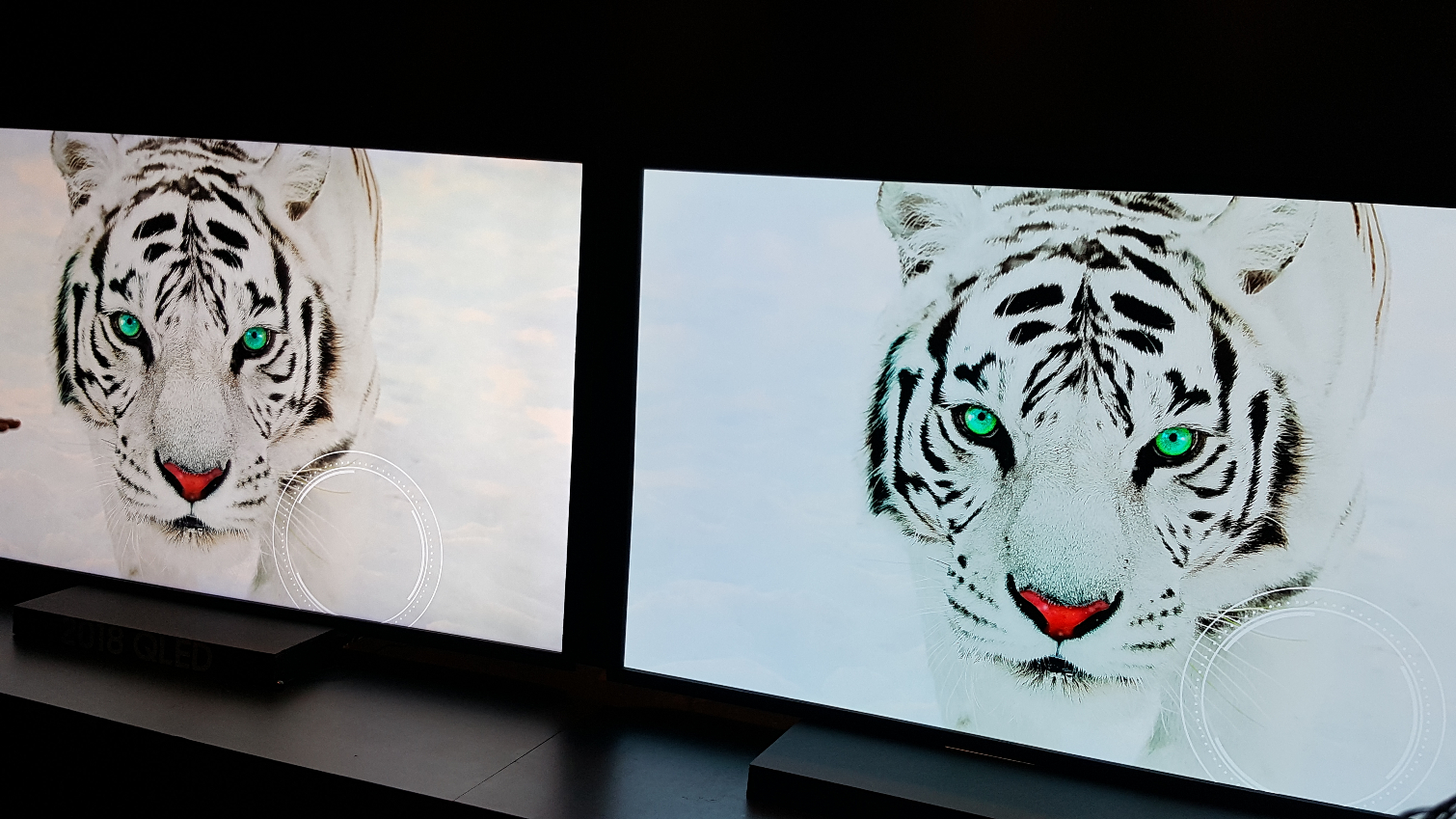Samsung Challenges OLED Supremacy with Next-Gen QLED
Samsung's QLED technology will get much better in 2018, if the gorgeous, richly colored displays we saw at CES 2018 are any indication.
LAS VEGAS — We’re only into the second year of Samsung’s QLED display technology being on the market, but new refinements coming to Samsung TVs in 2018 will dramatically improve the quality of QLED displays.

As the leading alternative to OLED in the premium consumer space, these display improvements narrow the gap between the two panel technologies. The result provides gorgeous pictures without the expense of OLED panels. Samsung’s second-generation QLED may not match OLED on every element, but it’s getting very, very close.
The Big Picture on QLED
Samsung’s QLED is the most prominent technology to feature Quantum Dot technology, improving LCD displays by pairing nanometer-scale semiconductors with standard LCD pixels to enhance picture quality. It’s an enhancement to regular LCD technology that delivers more vibrant color and deeper black levels than you would get on a standard panel that uses inter-plane switching (IPS) technology.
MORE: Best TVs
With the second generation coming from Samsung, improvements are aimed at QLED’s most notable weaknesses, specifically by improving black levels, expanding viewing angles and reducing reflectivity.
Samsung hasn't let press take many photos of the new QLED displays here at CES 2018, because the demonstration units are still early prototypes. But when viewed side-by-side with competing OLED panels, the improved QLED display shows a stark improvement over the first generation.
Processing Muscle for Prettier Picture Quality
As picture quality becomes more and more dependent upon processing capability, manufacturers are leaning into processing improvements as a source of improvements. Samsung is boosting the quality of its new displays with a combination of tweaks, including full volume color — which offers more than a billion colors — and better color in both dark and brightly lit scenes. It’s also boosting the brightness to help colors stand out more and deliver more vivid HDR content.
Better Filters for Better Black Levels
The first change is what Samsung is calling Black Enhanced Q Contrast. Special filtering has allowed a significant improvement in black levels, generally considered one of QLED's most significant weaknesses. It does so by reducing unwanted glow in dark colors and shadows, producing what comes very close to an OLED-level true black.
The anti-blooming technology uses a honeycomb-like nanoscale filter on top of the LCD pixels to provide appropriate brightness for each pixel itself while blocking unwanted illumination from surrounding pixel backlight. The result is not only improved black light and a reduction of the flaring and halos seen on current generation QLED panels.
It also provides the unexpected benefit of dramatically reducing reflection on the panel itself. Combined with an anti-reflective layer on the topmost layer of the panel, reflectivity is dropped well below that of other OLED and LCD displays. Instead of the black-mirror effect of seeing your own reflection on a display that is powered down, or just plain dark colors, you merely get a truer, almost reflectionless representation of the picture as presented by the original source.
Samsung calls it Ultra Black Elite, and it's an aspect of the TV viewing experience that I hadn't realized needed much improvement. But seeing the difference with my own eyes drove home how much better a TV looks with little to no reflection.
Micro-Lenses for Wider Viewing Angles
Another new layer within the QLED display is made up of micro-lenses that work in tandem with the filter to reduce unwanted glow from surrounding backlight. The micro-lens layer takes the filtered image and then puts it out with extra-wide viewing angles.
While the filter alone would actually result in narrower viewing angles if used alone, the addition of the micro-lens layer improves the angle beyond that of current QLED displays. With the new micro-lens technology in place viewing angles approach that of an IPS panel, but without the light leakage and elevated black levels seen on traditional IPS LCD displays.
Not Quite Perfect, But Closer
While the new displays show marked improvement over first generation QLED, and dramatically narrow the gap with premium OLED displays, there are still some faults. The most significant of these is still the existence of unwanted flaring and halos around bright objects when displayed on dark backgrounds. Improvements to the display technology can reduce such unwanted backlighting, but cannot yet eliminate it entirely.
That said, the improvements are astonishing, and while OLED still has a slight edge in picture quality, the difference is more academic than it has been in the past.
Pricing and Availability
Even though we can expect the new and improved form of QLED to come out of Samsung’s labs and show up in commercial models, Samsung hasn’t offered a timeline yet of when these improvements will come. Demos at CES all involve early prototypes — in some cases, hand-fabricated using tape instead of screen bezels. The company is eager to show people how its QLED technology has improved, but whether or not we’ll see it arrive in 2018 has yet to be announced.
Sign up to get the BEST of Tom's Guide direct to your inbox.
Get instant access to breaking news, the hottest reviews, great deals and helpful tips.
Brian Westover is currently Lead Analyst, PCs and Hardware at PCMag. Until recently, however, he was Senior Editor at Tom's Guide, where he led the site's TV coverage for several years, reviewing scores of sets and writing about everything from 8K to HDR to HDMI 2.1. He also put his computing knowledge to good use by reviewing many PCs and Mac devices, and also led our router and home networking coverage. Prior to joining Tom's Guide, he wrote for TopTenReviews and PCMag.

